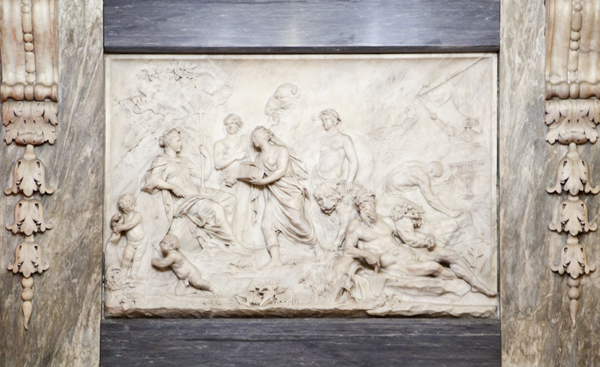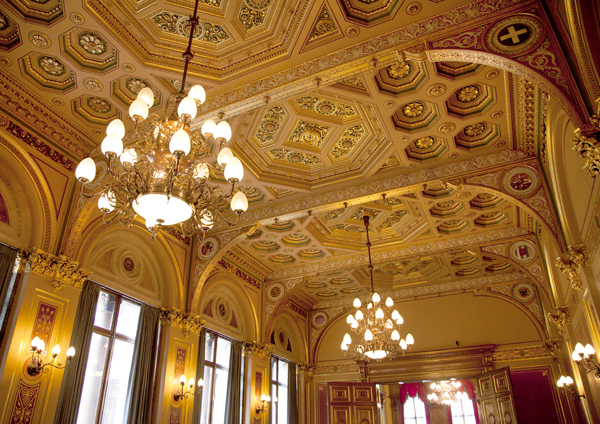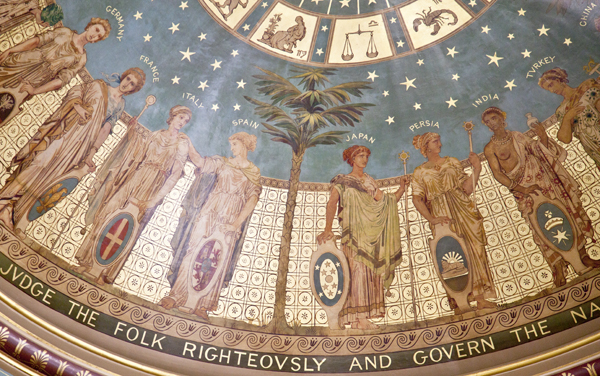The Foreign and Commonwealth Office has a very straight forward purpose – to elevate British interests overseas. And so from within its finely manicured walls derives the safeguarding of our national security, the initiating of prosperity through exports, investment and open markets, the promotion of sustainable global progress and a pillar for all British nationals across the globe to lean against through its consular services. Currently at the helm is of this mighty ship is Foreign Secretary, William Hague, who together with the Prime Minister, Chancellor of the Exchequer and Home Secretary, form the ‘Great Offices of State’, the four most venerable appointments in the Cabinet. Situated alongside Downing Street in Whitehall, it is where Britain extends its rather ornate, gilded hands to the world. But through all its pomp and ceremony this George Gilbert Scott building does exactly what it set out to say, – that we are world players and a force to be reckoned with.
The Foreign Office first came about in 1782 with the alliance of both Southern and Northern Departments of the Secretary of State, then splitting into ‘Foreign’ and ‘Home’ sectors. At the time, the vicinity of Downing Street was not the blue-ribbon enclave that it is today, with a hodgepodge of public houses, livery stables, dressmakers, affordable housing for minor MP’s compressed along narrow alleys, with stories of FO clerks acquiring strawberries via baskets on strings, throwing pennies to street vendors and flirtations with the pretty dressmakers across the way by signalling with mirrors. An underground stream made the area very boggy and unstable with a neighbouring house even falling down, with sections of the FO propped up with wooden supports. The FCO came about in 1968 with the amalgamation of the Commonwealth and Foreign Offices. The building itself presently occupies a space that comprised the old Foreign Office, India Office, Colonial Office and Home Office. The architect George Gilbert Scott initially lobbied for a gothic theme until the PM at the time, Viscount Palmerston, insisted on a more harmonious design and then opted for the Italianate approach. Over the years, owing to the ever-increasing numbers in personnel, much of the building’s fine effects have either been covered up or removed and by the 1960’s it was in such a state of disrepair that demolition loomed until public outcry enforced the Foreign Office to upgrade as a Grade I listed structure. In 1980 it was subjected to a 17-year £100 million facelift, thus returning it to its former glory and for yet another curtain call.
THE DURBAR COURT
This magnificent court was one of the few sections not designed by George Gilbert Scott, but by Matthew Digby Wyatt. ‘Durber’ means ‘court’ in Indian and is an understated homage to both Italian and Indian techniques, based loosely on Rome’s Palazzo de Cancelleria. Originally intended as an open cortile, the eventual roof takes influence from Wyatt’s work with the Crystal Palace for the Great Exhibition of 1851 and Paddington Station. The real magic becomes clear as your eyes work up the walls with the detail becoming greater the higher you go up.
THE INDIA OFFICE COUNCIL CHAMBER
Also the work of Wyatt, this marvel of a room was designed solely for the Secretary of State for India and meetings regarding the subcontinent up until 1947 when India Office ceased to prevail. The central panel above the fireplace was made by Flemish sculptor Michael Rysbrack in 1730, depicts Britannia receiving gifts from the East, with the figure leading a camel representing the East and the figure with a lion, the West.
THE MUSES’ STAIR
This staircase is roofed with an octagonal glass dome, graced by goddesses of plenty (canephora) and cherubs illustrating the Roman virtues (Auctoritas, Dignitas, Gravitas, Hospitium, Otium, Pietas, Virtus, etc.) Directly beneath hang a pair of portraits of Emperor Napoleon III and Empress Eugenie, gifted to the East India Company in gratitude of its benefaction to the Paris Exhibition of 1855.
THE LOCARNO SUITE
Three successive rooms that were designed by Scott as the main area for diplomatic dinners, functions and conferences. First comes the Cabinet Room, followed by the Dining Room and Conference Room, whose gilded ceiling is decorated with circular majolica plaques bearing national emblems of twenty countries (USA, Turkey, Saxony, Switzerland, Sweden & Norway, Spain, Russia, Papal States, Portugal, Prussia, Austria, Belgium, Bavaria, China, Denmark, France, Greece, Holland, Italy and Japan)
GRAND STAIRCASE
The unforseen pivot behind this awe-inspiring staircase is not the exaggerated and bedazzling ceiling, but in fact the highly illustrious Sigismund Goetze murals that literally float off the walls that encircle the staircase. They depict the genesis, guidance, growth and achievement of the British Empire using a restricted palette of yellow ochre, Venetian red , cobalt and flake white. By fighting shy of bolder colours, Goetze had hoped the murals would stand their ground amongst their bold and brassy surroundings, that the feeling of light and air would not interrupt the structure of columns and the narrowness of the walls.

Britannia Nutrix – nurturing a resilient nation through the arts of peace (ploughing, music, pottery, wool spinning and reading)

Britannia Sponsa – the successive invasions of Britannia over the centuries presided over by the vision of the angel with the grail, a symbol of the Glastonbury legend and founding of Christianity in Britain.
[The Foreign Office can be viewed by the general public each year through Open House London]

























































